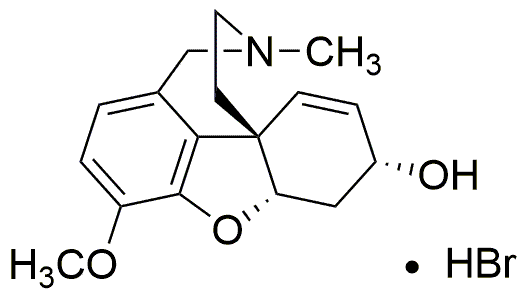Galanthamine hydrobromide from Lycoris sp. is widely utilized in research focused on:
- Alzheimer's Disease Treatment: This compound is primarily used in the management of Alzheimer's disease, enhancing cognitive function by inhibiting acetylcholinesterase, an enzyme that breaks down acetylcholine, a neurotransmitter crucial for memory and learning.
- Neuromuscular Disorders: It has applications in treating neuromuscular disorders, such as myasthenia gravis, by improving neuromuscular transmission and muscle strength, providing patients with better quality of life.
- Research in Neuropharmacology: Galanthamine is a valuable tool in neuropharmacological studies, helping researchers understand the mechanisms of neurotransmission and the effects of cholinergic drugs on the nervous system.
- Potential in Pain Management: Emerging studies suggest its potential in pain management, particularly in neuropathic pain, due to its neuroprotective properties and ability to modulate pain pathways.
- Botanical Research: As a natural alkaloid derived from Lycoris species, it is also used in botanical studies to explore the pharmacological properties of plant-derived compounds, contributing to the field of natural product chemistry.
General Information
Properties
Safety and Regulations
Applications
Galanthamine hydrobromide from Lycoris sp. is widely utilized in research focused on:
- Alzheimer's Disease Treatment: This compound is primarily used in the management of Alzheimer's disease, enhancing cognitive function by inhibiting acetylcholinesterase, an enzyme that breaks down acetylcholine, a neurotransmitter crucial for memory and learning.
- Neuromuscular Disorders: It has applications in treating neuromuscular disorders, such as myasthenia gravis, by improving neuromuscular transmission and muscle strength, providing patients with better quality of life.
- Research in Neuropharmacology: Galanthamine is a valuable tool in neuropharmacological studies, helping researchers understand the mechanisms of neurotransmission and the effects of cholinergic drugs on the nervous system.
- Potential in Pain Management: Emerging studies suggest its potential in pain management, particularly in neuropathic pain, due to its neuroprotective properties and ability to modulate pain pathways.
- Botanical Research: As a natural alkaloid derived from Lycoris species, it is also used in botanical studies to explore the pharmacological properties of plant-derived compounds, contributing to the field of natural product chemistry.
Documents
Safety Data Sheets (SDS)
The SDS provides comprehensive safety information on handling, storage, and disposal of the product.
Product Specification (PS)
The PS provides a comprehensive breakdown of the product’s properties, including chemical composition, physical state, purity, and storage requirements. It also details acceptable quality ranges and the product's intended applications.
Certificates of Analysis (COA)
Search for Certificates of Analysis (COA) by entering the products Lot Number. Lot and Batch Numbers can be found on a product’s label following the words ‘Lot’ or ‘Batch’.
Número de catálogo
Número de lote/lote
Certificates Of Origin (COO)
This COO confirms the country where the product was manufactured, and also details the materials and components used in it and whether it is derived from natural, synthetic, or other specific sources. This certificate may be required for customs, trade, and regulatory compliance.
Número de catálogo
Número de lote/lote
Safety Data Sheets (SDS)
The SDS provides comprehensive safety information on handling, storage, and disposal of the product.
DownloadProduct Specification (PS)
The PS provides a comprehensive breakdown of the product’s properties, including chemical composition, physical state, purity, and storage requirements. It also details acceptable quality ranges and the product's intended applications.
DownloadCertificates of Analysis (COA)
Search for Certificates of Analysis (COA) by entering the products Lot Number. Lot and Batch Numbers can be found on a product’s label following the words ‘Lot’ or ‘Batch’.
Número de catálogo
Número de lote/lote
Certificates Of Origin (COO)
This COO confirms the country where the product was manufactured, and also details the materials and components used in it and whether it is derived from natural, synthetic, or other specific sources. This certificate may be required for customs, trade, and regulatory compliance.


